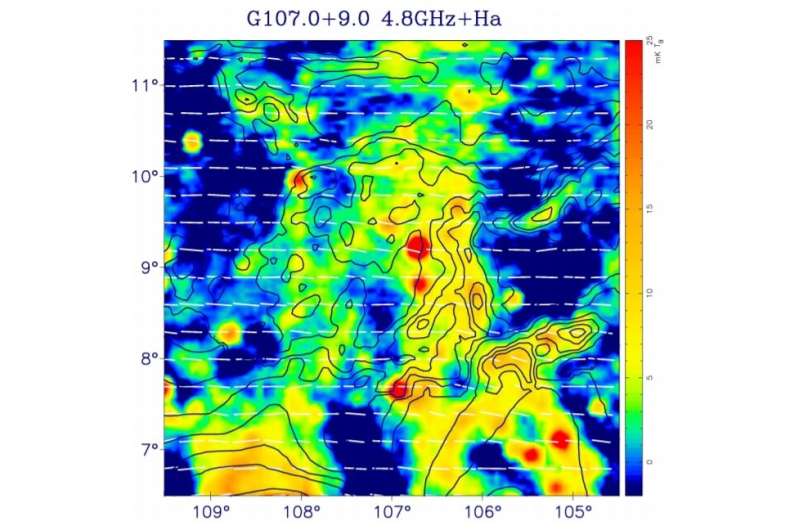August 25, 2021 report
Study investigates radio properties of supernova remnant G107.0+9.0

Astronomers from Germany and China have performed detailed radio observations of a supernova remnant (SNR) known as G107.0+9.0. Results of the observational campaign yield important insights into the radio properties of this source. The study was published August 19 on arXiv.org.
SNRs are diffuse, expanding structures resulting from a supernova explosion. They contain ejected material expanding from the explosion and other interstellar material that has been swept up by the passage of the shockwave from the exploded star.
Studies of supernova remnants are important for astronomers, as they play a key role in the evolution of galaxies, dispersing the heavy elements made in the supernova explosion and providing the energy needed for heating up the interstellar medium (ISM). SNRs are also believed to be responsible for the acceleration of galactic cosmic rays.
At a distance of between 5,000 and 6,500 light years away, G107.0+9.0 is a large (estimated to be 244-326 light years in size) optically bright, radio and X-ray faint Galactic SNR in the Cepheus constellation. Previous studies of this SNR have shown that it showcases a faint associated radio emission that requires further inspection.
So a team of astronomers led by Wolfgang Reich of the Max Planck Institute for Radio Astronomy in Bonn, Germany, has conducted a search for radio emission from G107.0+9.0 by analyzing new data from the Effelsberg 100-m and the Urumqi 25-m radio telescopes. The study was complemented by archival data from various available radio surveys.
"We extracted faint radio emission from the optically identified SNR G107.0+9.0 from published surveys at 22 MHz and 408 MHz and new observations at 1.4 GHz and 4.8 GHz," the researchers wrote in the paper.
The observations detected radio emission from G107.0+9.0 between 22 MHz and 4.8 GHz with a steep non-thermal spectrum, which confirms the SNR nature of this source. The astronomers explained that the radio emission was found to have a non-thermal integrated spectral index of −0.95. This is steeper than that of typical shell-type SNRs in the adiabatic evolution phase, which have a spectral index of about −0.5.
According to the study, G107.0+9.0 does not show the typical morphology of a shell-type SNR and may be in the radiative phase. Its surface brightness at 1.0 GHz was found to be among the lowest currently known for supernova remnants.
Furthermore, the research detected polarized emission at 1.4 GHz and 4.8 GHz. This polarized emission extends beyond the boundaries of G107.0+9.0, hence the astronomers assume that it is a result of a Faraday screen (FS) hosting a faint ordered magnetic field along the line of sight.
Summing up the results, the authors of the paper noted that the properties of G107.0+9.0 make it a unique SNR.
"G107.0+9.0 adds to the currently small number of known, evolved, large-diameter, low-surface-brightness Galactic SNRs," they explained.
More information: Wolfgang Reich et al, Radio properties of the optically identified supernova remnant G107.0+9.0, arXiv:2108.08575v1 [astro-ph.GA] arxiv.org/abs/2108.08575
© 2021 Science X Network





















